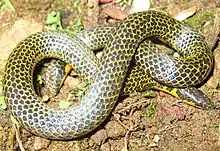Uropeltis madurensis
Uropeltis madurensis, the Madurai shieldtail, is a small, fossorial, non venomous, snake of the family Uropeltidae, endemic to the Western Ghats of South India.[1]
| Uropeltis madurensis | |
|---|---|
 | |
| Scientific classification | |
| Kingdom: | Animalia |
| Phylum: | Chordata |
| Class: | Reptilia |
| Order: | Squamata |
| Suborder: | Serpentes |
| Family: | Uropeltidae |
| Genus: | Uropeltis |
| Species: | U. madurensis |
| Binomial name | |
| Uropeltis madurensis (Beddome, 1878) | |
| Synonyms | |
| |
Taxonomic notes
This species was formerly considered a subspecies of another species Uropeltis arcticeps,[2] until a recent systematic revision revealed this to be a distinct species.[3]
History
This species was first described by Richard Henry Beddome in 1878, when he collected the type specimen from the High Wavy Mountains or Meghamalai Hills.[4]
Etymology
Refers to the geographic range of the species, near the prominent town Madurai, in Tamil Nadu State.
Identification
Uropeltis madurensis can be diagnosed by the following combination of characters: tail shield with clearly defined, thickened, circumscribed disc; part of rostral visible from above not distinctly longer than its distance from frontal; rostral not fully separating nasals; dorsum uniform brown, each scale with a well-defined lighter golden yellowish outline; ventrals 144–157; venter with alternate rhomboidal large brown and orange spots or blotches, the two colours of equal intensities.[3]
Distribution and natural history
Uropeltis madurensis is endemic to the Cardamom Hills consisting of Megamalai Wildlife Sanctuary and Grizzled Squirrel Wildlife Sanctuary in Tamil Nadu and the Periyar Tiger Reserve of Kerala, present in the Western Ghats. A forest species, partial to montane forests, cloud forest and tropical rainforest, this species also occurs marginally in cardamom, coffee and tea plantations situated amidst primary forests.
A fossorial, nocturnal snake, known to hide under stones, fallen logs and rocks during day time. Active during rains, in the monsoon season, especially after dark, where they come on to land and forage. Food principally believed to be of earth worm. Habitat loss and Roadkill are primary threats affecting this rare species.
References
- Pyron; et al. (2016). "A catalogue and systematic overview of the shield-tailed snakes (Serpentes: Uropeltidae)". Zoosystema. 38 (4): 453–506. doi:10.5252/z2016n4a2.
- Whitaker, Captain (2004). Snakes of India: the field guide. India: Draco Books. p. 554.
- Ganesh; et al. (2014). "Taxonomic reassessment of two Indian shieldtail snakes in the Uropeltis ceylanicus species group (Reptilia: Uropeltidae)". Journal of Threatened Taxa. 6 (1): 5305–5314. doi:10.11609/JoTT.o3636.5305-14.
- Beddome, R.H. (1878). "Description of six new species of snakes of the genus Silybura, family Uropeltidae". Proc. Zool. Soc. London.: 800–802.